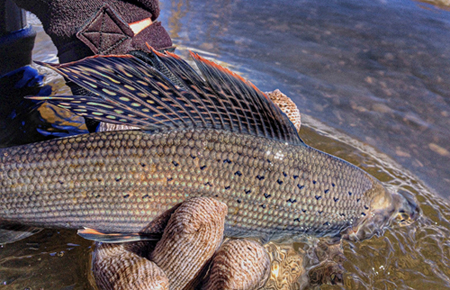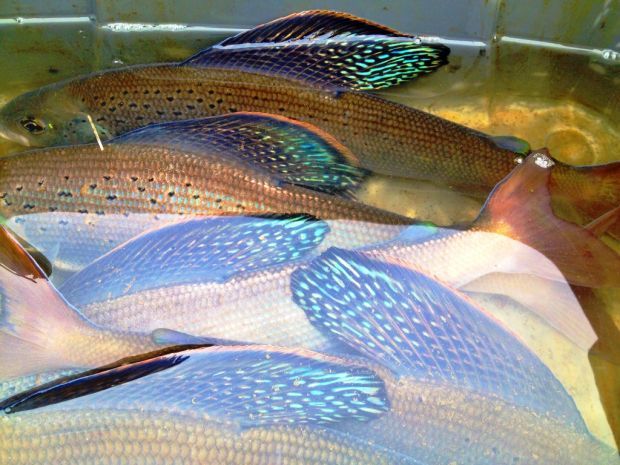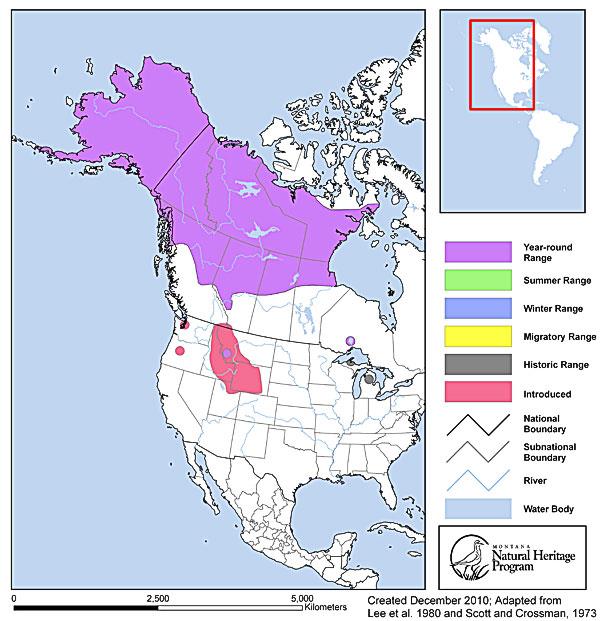Fish in Focus: Arctic Grayling, Thymallus arcticus

© Jason Satoshi Ching used with permission
Ninety Six, SC
Cruising the cold, clear waters of northern-most North America, the Arctic Grayling (Thymallus arcticus) is a modest-sized game fish on many an angler’s bucket list. While the largest specimens max out at roughly 30 inches and 8 pounds, the average adult will be somewhere between 6 and 14 inches and weigh substantially less.
So if it isn’t their size, what is it that attracts sportsmen and women to this fish? Well, for starters, they are spunky fighters. What appeals to so many people though is that this is a beautiful fish found in beautiful places. Many game fishes are just plain ugly when they get big (I’m looking at you, Largemouth Bass). Others get wicked looking(Hello, Sockeye). But no matter what size a Grayling may be, even at its plainest it is a pretty fish. When feeling their best they are some of the most beautiful fish on the planet. Lucky are the regions that call them native sons and daughters; the Arctic and Pacific drainages of the US and Canada, as well as several central Canadian waters and portions of Wyoming and Montana.

Arctic Grayling sporting chevron-shaped splotches. (Photo by Andrew Gilham, USFWS) |

Subtle differences. (Photo by Jim Mogen, USFWS) |

Western Hemisphere range map for Arctic Grayling from Montana Field Guide (Montana Natural Heritage Program and Montana Fish, Wildlife and Parks. http://fieldguide.mt.gov/speciesDetail.aspx?elcode=AFCHA07010 |
For being so consistently attractive, they can be rather variable in appearance. Arctic Grayling flaunt a trout-like build, long but muscular. Their mouths are small and their jaws are toothed. A Grayling’s sides can vary from a silvery-gray, to blue, to almost a pinkish color. The front half of its body is splashed with black spots. Sometimes these spots are actually more chevron shaped. Depending on lighting and mood, an Arctic Grayling may seem to meld all these characteristics together at one time. What really sets the Grayling apart is its fins. Adding to its trout-like appearance is a forked caudal fin and a fleshy adipose fin. Pelvic fins sport orangish stripes. Distinguishing it from the trouts is it gorgeous, long, flowing dorsal fin. Female dorsals tend to be rounded while males are more pointed, but they are all quite spectacular. Like their body coloration, Grayling dorsal fins can be variable in coloration. They may be of a purplish to black background color, with reddish spots occurring between the rays. Towards the end of the dorsal fin electric blue spots morph into streaks shaped much like drops of rain that grow and spread as they run down the windshield of a car. Like many animals, this fish has seen its fair share of drama. On one hand human activities have extirpated it from portions of its original range, such as Michigan’s Great Lake drainages, while on the other it has been introduced into at least 25 states! Some of those efforts have had a measure of success but most have not. Yellowstone National Park is working to restore Arctic Grayling habitat while the State of Alaska recently announced it was reducing Grayling husbandry and stocking due to the relative expense of breeding them. The US Fish and Wildlife Service recently ruled that Arctic Grayling in Montana do not warrant an endangered species listing due to conservation efforts in the area. Rising temperatures in the far north have led to concerns that the water may be too warm to be healthy for them. In at least one Alaskan lake this past summer there was a substantial die-off of large adult Grayling due to white spot disease, ichthyophthiriasis. A proper examination of this beautiful fish would take more space than Fish in Focus has to offer. The following resources were used in this brief sketch, consult them for more information. |
Pertinent Literature:
http://www.alaskapublic.org/2015/07/03/state-will-discontinue-filling-grayling-in-alaska-lakes/
http://www.biokids.umich.edu/critters/Thymallus_arcticus/
http://nas.er.usgs.gov/queries/factsheet.aspx?SpeciesID=943
http://peninsulaclarion.com/news/2015-12-19/white-spot-disease-kills-arctic-grayling-in-scout-lake
Page, L.M., and B.M. Burr. 2011. Peterson Field Guide to Freshwater Fishes of North America North of Mexico. Second edition. Houghton Mifflin Harcourt Publishing Co. 663 p.